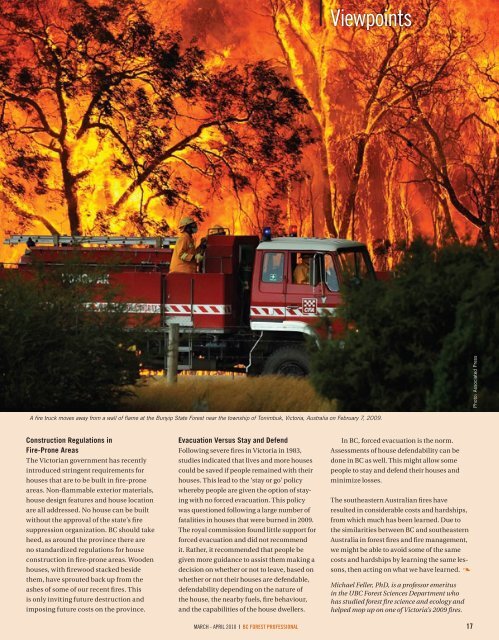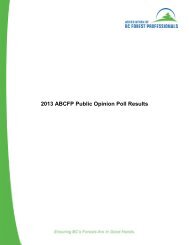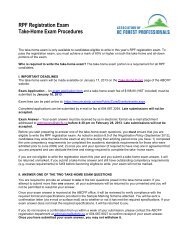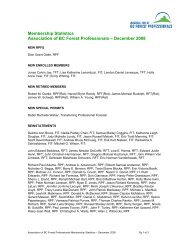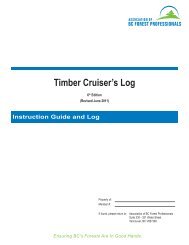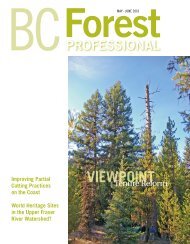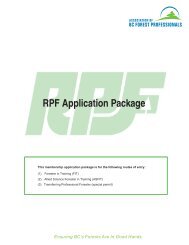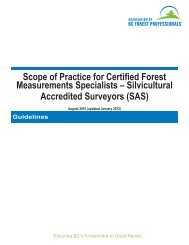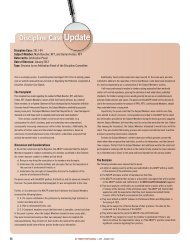VIEWPOINT - Association of BC Forest Professionals
VIEWPOINT - Association of BC Forest Professionals
VIEWPOINT - Association of BC Forest Professionals
You also want an ePaper? Increase the reach of your titles
YUMPU automatically turns print PDFs into web optimized ePapers that Google loves.
Construction Regulations in<br />
Fire-Prone Areas<br />
The Victorian government has recently<br />
introduced stringent requirements for<br />
houses that are to be built in fire-prone<br />
areas. Non-flammable exterior materials,<br />
house design features and house location<br />
are all addressed. No house can be built<br />
without the approval <strong>of</strong> the state’s fire<br />
suppression organization. <strong>BC</strong> should take<br />
heed, as around the province there are<br />
no standardized regulations for house<br />
construction in fire-prone areas. Wooden<br />
houses, with firewood stacked beside<br />
them, have sprouted back up from the<br />
ashes <strong>of</strong> some <strong>of</strong> our recent fires. This<br />
is only inviting future destruction and<br />
imposing future costs on the province.<br />
Evacuation Versus Stay and Defend<br />
Following severe fires in Victoria in 1983,<br />
studies indicated that lives and more houses<br />
could be saved if people remained with their<br />
houses. This lead to the ‘stay or go’ policy<br />
whereby people are given the option <strong>of</strong> staying<br />
with no forced evacuation. This policy<br />
was questioned following a large number <strong>of</strong><br />
fatalities in houses that were burned in 2009.<br />
The royal commission found little support for<br />
forced evacuation and did not recommend<br />
it. Rather, it recommended that people be<br />
given more guidance to assist them making a<br />
decision on whether or not to leave, based on<br />
whether or not their houses are defendable,<br />
defendability depending on the nature <strong>of</strong><br />
the house, the nearby fuels, fire behaviour,<br />
and the capabilities <strong>of</strong> the house dwellers.<br />
MARCH - ApRil 2010 | <strong>BC</strong> FOREST PROFESSIONAL<br />
Viewpoints<br />
A fire truck moves away from a wall <strong>of</strong> flame at the Bunyip State <strong>Forest</strong> near the township <strong>of</strong> Tonimbuk, Victoria, Australia on February 7, 2009.<br />
In <strong>BC</strong>, forced evacuation is the norm.<br />
Assessments <strong>of</strong> house defendability can be<br />
done in <strong>BC</strong> as well. This might allow some<br />
people to stay and defend their houses and<br />
minimize losses.<br />
The southeastern Australian fires have<br />
resulted in considerable costs and hardships,<br />
from which much has been learned. Due to<br />
the similarities between <strong>BC</strong> and southeastern<br />
Australia in forest fires and fire management,<br />
we might be able to avoid some <strong>of</strong> the same<br />
costs and hardships by learning the same lessons,<br />
then acting on what we have learned. 3<br />
Michael Feller, PhD, is a pr<strong>of</strong>essor emeritus<br />
in the U<strong>BC</strong> <strong>Forest</strong> Sciences Department who<br />
has studied forest fire science and ecology and<br />
helped mop up on one <strong>of</strong> Victoria’s 2009 fires.<br />
Photo: Associated Press<br />
17


